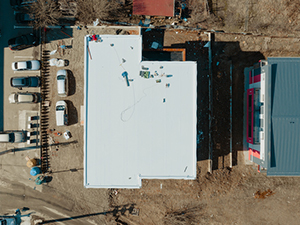
A leaking roof can quietly cause serious damage to your property, long before you see water stains or dripping ceilings. That is why early, and accurate roof leak detection is essential for protecting your building’s structure, insulation, and interior finishes. In Battle Creek, MI, where unpredictable weather and seasonal changes can accelerate roof wear, relying on professional leak detection services is a smart move.
At JM Roofing Solutions, we specialize in fast, non-invasive roof leak detection. Using advanced technology and hands-on expertise, we pinpoint the exact source of leaks so you can avoid unnecessary repairs and stop water damage before it spreads.
Call JM Roofing Solutions at (269) 361-8305 for expert roof leak detection in Battle Creek, MI.
Professional Leak Detection Matters
Many roof leaks are not immediately visible. Water may travel along rafters, insulation, or even electrical conduits before becoming apparent inside your building. That means the visible signs of a leak may be far from the actual source.
Trying to patch what you can see, without understanding where the leak originates, often leads to repeat issues and added costs. Professional leak detection identifies:
- Hidden moisture beneath membranes
- Small punctures or cracks invisible to the eye
- Compromised seams or flashing
- Improper drainage or ponding water
- Degraded roofing material due to UV exposure or age
When performed by experienced roofing specialists like JM Roofing Solutions, this process saves time, protects your property, and ensures repairs are done right the first time.
Roof Leak Detection Process

Our approach to leak detection is both thorough and minimally invasive. We use a combination of visual inspection, infrared moisture scanning, and electronic leak detection (depending on roof type and conditions) to find the source of the problem.
Visual Inspection – We begin with a surface evaluation of your roof, checking flashing, seams, penetrations, and signs of wear.
Moisture Mapping – Using infrared cameras or moisture meters, we locate areas where water has infiltrated the roof system.
Pinpointing the Leak – Once we have traced the moisture path, we identify the precise entry point—whether it is a crack, seam gap, or failing fastener.
Documentation and Recommendations – You receive a detailed report of our findings along with repair options tailored to your roof system and budget.
This comprehensive process ensures we do not just guess, we find the leak at its source and recommend a fix that lasts.
Common Causes of Roof Leaks
Several factors contribute to roof leaks in our region:
Storm Damage – Hail and wind can loosen or puncture roofing materials.
Age-Related Wear – Older roofs may show seam failure, cracked membranes, or weakened underlayment.
Drainage Issues – Clogged or misaligned gutters and drains can cause water to back up and find weak spots.
Improper Installation – Faulty flashing or poorly sealed edges can create easy entry points for water.
No matter the cause, early detection gives you the best chance at preventing expensive interior repairs and prolonging the life of your roof.
Roof Leak Detection Experts
Call JM Roofing Solutions at (269) 361-8305 today for professional roof leak detection in Battle Creek, MI. We will help you identify the problem quickly and offer the right solution to keep your building dry and secure.
FAQ
How do I know if I have a hidden roof leak?
Look for subtle signs like musty odors, bubbling paint, or higher energy bills. These can signal moisture intrusion even without visible water stains.
Can leak detection be done without damaging the roof?
Yes, we use infrared and electronic tools that allow for non-invasive detection, avoiding the need to tear up the roof unnecessarily.
Is leak detection necessary if I already see where it is dripping?
Yes, water often travels from the entry point. We trace it back to the actual source to ensure the repair is effective and permanent.
How soon should I act on a suspected roof leak?
Immediately. Delays can lead to mold, insulation damage, structural weakening, and higher repair costs.
